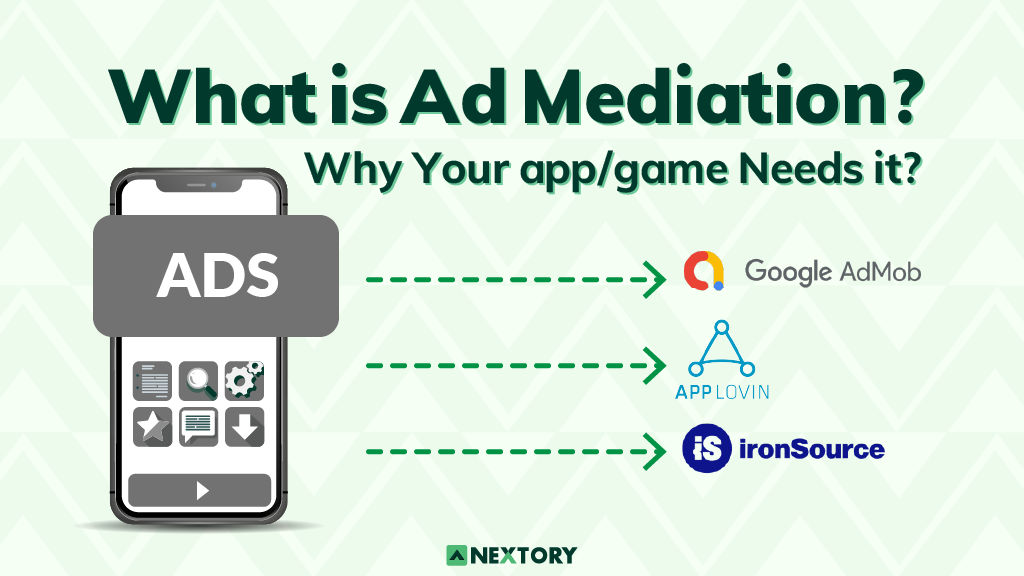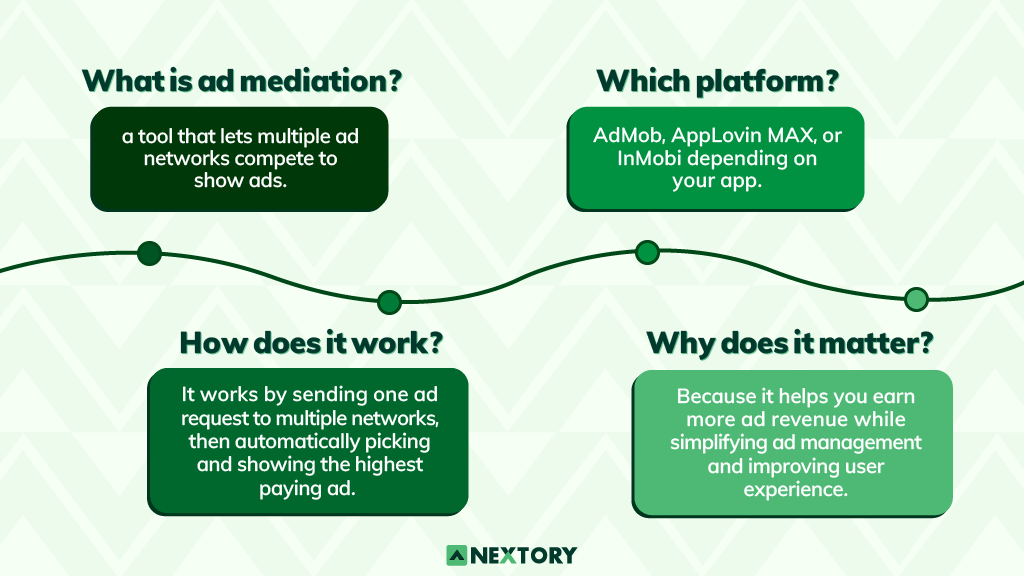Ad Mediation in Simple Words: Why Your app/game Needs it?

Tired of low ad revenue and messy SDKs? Ad mediation might be the fix you need. In this quick guide, you’ll learn what it is, how it works, and why it can seriously boost your app’s earnings, with less hassle.
What is Ad Mediation?

Ad mediation is a software that lets you plug multiple ad networks into your app through one lightweight SDK.
The mediation platform asks several networks to pay up their best price and then serves the highest-paying ad automatically.
How Does Ad Mediation Work?
When someone opens your app, the mediation tool steps in and looks for an ad to show.
Instead of asking just one ad network, it asks several networks at the same time to offer their best price.
The one that’s willing to pay the most gets to show their ad. This all happens in the background, instantly. You don’t have to manage it manually, the mediation platform takes care of it, helping you earn more from each ad spot without adding extra work.
Core Concepts
Let’s break down a few terms you’ll run into as you explore ad mediation:

Ad Mediation Network
Or an ad mediation platform, simply refers to the software that runs the show. There are some well-known names in the market like AdMob Mediation, AppLovin MAX, or ironSource Mediation.
They handle the auction between different ad networks behind the scenes.
Waterfall
The most traditional approach is called the waterfall model. It works by trying ad networks one at a time.
If the first one doesn’t fill the request, it moves to the next. It’s simple and predictable, which is why it’s still widely used, especially when working with niche or smaller ad partners.
Header Bidding
A more modern and effective method is header bidding. Instead of waiting in line, all networks get the chance to bid at the same time. The one offering the highest price wins.
This often leads to higher revenue and faster ad loading times. It’s especially useful if you work with large, competitive networks.
Hybrid Mediation
This method mixes both. Some networks bid in real-time (like in header bidding), while others are placed in a waterfall order as backup.
It’s a smart choice if not all your partners support real-time bidding.
Mediation SDK (Software Development Kit)
It is the small bit of code you add to your app. It lets your app communicate with the mediation platform and request ads without needing multiple SDKs for each network.
eCPM
It stands for “effective cost per thousand impressions”. It’s the average amount of money you earn for every 1,000 ad views. The higher it is, the better.
These might sound confusing, just understand the idea: mediation tools help you show the best-paying ad, from the best source, with the least effort.
Benefits for Developers and Companies
Ad mediation lets ad networks compete for every impression, boosting your earnings with higher eCPM, higher fill rates, and much more.
Here are what you get from using an ad mediation:
- Higher fill rates → fewer empty slots → more impressions.
- Higher eCPM because networks bid against each other.
- Single SDK → lighter app, faster updates, fewer crashes.
- Central analytics → one dashboard instead of five.
- Automatic A/B testing of ad formats without extra code.
Which Ad Mediation Platform Suits You?
Not all mediation platforms are the same, so it’s important to pick one that fits your app’s needs.
Here are a few things to look for:
First, check if the platform supports the tools you use, like iOS, Android, Unity, or Flutter. Some platforms work better with certain app types or coding environments.
Platform Compatibility
Next, make sure it connects with the ad networks you already use or plan to work with.
The more strong networks it supports, the better your chances of earning more.
Also look at the reporting. A good platform should show you clear data, like where your users are, which ad units are performing best, and how much money you’re making.
Cost Management and Reliabilty
Consider the cost too. Some platforms take a cut of your earnings, while others charge a fee or offer a free plan.
Reliability matters, you don’t want ads to stop showing because of server issues. Look for a platform with strong uptime and fast ad delivery.
Strong Support
Finally, check support options. Do they offer help when things go wrong? Are there guides, email support, or even a Slack community?
Some of the top platforms used by developers today include AdMob Mediation, AppLovin MAX, and InMobi. Each of them has its own strengths depending on your app size and goals.
Common Pitfalls and How to Avoid Them
Ad mediation is a powerful tool, but it’s not perfect. You might face issues like poor ad quality, slower load times, or less control over what’s shown.
One common issue is losing control over ad quality. If you don’t set rules for what kind of ads are allowed, users might see spammy, irrelevant, or even inappropriate content.
This can lead to negative reviews, lower app ratings, and users uninstalling your app.
Technical Issues
Another problem is technical complexity. If the SDK isn’t set up properly or becomes outdated, ads might load slowly, or not served not at all.
That means lost revenue and a poor user experience.
Optimization Methods
There’s also the risk of not optimizing your waterfall or bidding setup.
If you don’t review your settings regularly, you might leave money on the table by serving low-paying ads or not giving top networks a chance to bid.
The good news? With the right setup and regular checks, most of these problems are easy to avoid.
Here are some of the most important pitfalls and how to solve them:
- Loss of control
Solution: build custom waterfalls for VIP ones.
- Technical debt
Solution: keep SDKs updated; schedule “SDK spring-clean” every quarter.
- Ad-quality issues
Solution: set strict category blocks, test on low-latency Wi-Fi and 3G, and review screenshots weekly.
Tip: start with one test app, measure KPIs for a week, then roll out to the rest of your portfolio.
FAQs
- What’s the difference between mediation and an ad exchange?
Mediation is a tool for publishers which sends one ad request to several networks and picks the highest offer. An ad exchange is a real-time marketplace where advertisers bid against each other to show their ads on mobile apps.
- Is AdMob a mediation platform?
Yes. Google’s AdMob offers a built-in mediation feature that lets you plug in ad networks through a single SDK.
Conclusion
Ad mediation is a smart way to boost your app revenue and simplify your setup. It lets multiple ad networks compete for each impression, so you earn more with less effort.
Plus, it helps deliver better, faster ads for your users, all through one simple SDK and dashboard.
If you’re still juggling separate SDKs, or relying on a single network, it’s time to test mediation. Start small, measure results, and watch your revenue climb.
